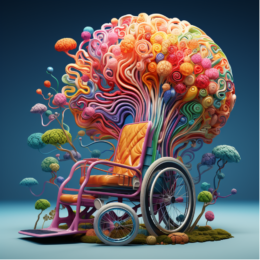What Are the Stages of Degenerative Disc Disease?

We thought you might like these, too:
- Introductory Chapter: Advances in the Diagnosis and Management of Rare Diseases
- How is Cerebral Palsy Diagnosed? (A Comprehensive Guide)
- Huntington’s Disease: Symptoms, Diagnosis & Management
- ‘Not Alone in the Dark’: New Guide for, by Caregivers of Children With Rare Diseases
- FAQs About Rare Diseases
Welcome to the world of spinal health, where the journey through degenerative disc disease might seem daunting, but with the right knowledge, you can embark on a path to understanding, managing, and potentially alleviating the discomfort it brings. In this article, we will delve into the 4 stages of disc degeneration and the rate at which DDD progresses. We’ll also discuss the variations in DDD, from mild disc degeneration to moderate degenerative disc disease and severe degenerative disc disease. To help us understand these stages better, we’ll follow Sarah, a vibrant 50-year-old, on her journey through DDD.
What Is Degenerative Disc Disease?
Degenerative disc disease (DDD) isn’t as scary as it might sound. It’s a natural part of aging, much like wrinkles and gray hair. However, understanding it is crucial to managing it effectively. DDD primarily affects the discs between our spinal vertebrae, causing them to lose their cushioning ability over time.
What Causes Degenerative Disc Disease?
DDD’s root cause is primarily attributed to the aging process, but it can also be influenced by various factors like genetics, smoking, obesity, and occupational hazards. As we age, our spinal discs lose moisture and become less flexible, leading to wear and tear.
Statistics:
- DDD affects about 40% of people aged 40 and over.
- It’s more prevalent in men than women.
Symptoms
For many, DDD goes unnoticed until it progresses to later stages. However, there are some common symptoms to watch out for:
- Back pain, especially when sitting or bending
- Pain that radiates to the buttocks, thighs, or legs
- Numbness or tingling in the extremities
- Weakness in the legs
What Does Degenerative Disc Pain Feel Like?
Imagine waking up one day with a dull ache in your lower back. It’s the kind of discomfort that nags at you, making it hard to concentrate on anything else. As DDD progresses, this pain can become more intense, often resembling a persistent, nagging discomfort that never seems to go away.

Sarah’s Story
Meet Sarah, a vibrant 50-year-old who faced the relentless grip of persistent back pain that radiated down her legs. A diagnosis of moderate degenerative disc disease left her on a path filled with challenges and triumphs. Sarah’s journey is a powerful testament to resilience and hope, inspiring others to share their own experiences and create a supportive discussion space.
What Are the Stages of Degenerative Disc Disease?
Understanding the progression of degenerative disc disease (DDD) is crucial in managing this common condition effectively. Degenerative disc disease typically progresses through four stages, and Sarah has bravely navigated each of them:
Stage 1: Normal Disc
In the early days of her journey, Sarah’s discs were healthy and functioning optimally. They provided flexibility and cushioning to her spine, allowing her to move freely without discomfort. It was a time when Sarah’s back felt strong, much like a smooth, well-maintained road.
Stage 2: Mild Disk Degeneration
As time passed, Sarah noticed changes in her discs. They began to lose some of their water content, making them slightly less efficient at shock absorption. This gradual process led to occasional back pain, especially after prolonged periods of sitting or bending. Sarah, like many others, found this discomfort manageable, akin to a road with minor potholes that required occasional attention.
Stage 3: Moderate Degeneration
Sarah’s journey continued into the third stage of DDD, characterized by more significant changes in her spinal discs. The ongoing loss of moisture caused her discs to become less resilient, and they developed small tears. At this point, Sarah experienced more frequent and intense pain, particularly when engaging in activities that involved bending or lifting. Her mobility became compromised, similar to a road that had seen more wear and tear, with uneven surfaces demanding careful navigation.
Stage 4: Severe Degeneration
In the final stage of DDD, Sarah’s spinal discs had undergone substantial degeneration. They were noticeably thinner, providing limited cushioning to her spine. This led to chronic and often debilitating pain, reduced mobility, and, in Sarah’s case, nerve compression, resulting in radiating pain down her legs. It was as if her road was filled with deep potholes and cracks, making every movement a challenge.
Understanding the stages of DDD empowers you to take proactive steps in managing your condition. Whether you’re in the early stages or facing more advanced degeneration, there are various treatment options and lifestyle modifications available to help you navigate the road ahead with greater comfort and resilience.
Quick Poll
Thank you for participating in our poll! Your responses help us better understand our community and create content that addresses your needs.
How Is Degenerative Disc Disease Diagnosed?
If you suspect you have DDD, it’s essential to consult a healthcare professional. Diagnosis often involves a combination of medical history, physical examination, and imaging tests like X-rays or MRI scans. Remember, early detection can make a significant difference in managing the condition effectively.
How Fast Does Degenerative Disc Disease Progress?
The progression rate of DDD varies from person to person. Factors like genetics, lifestyle, and overall health can influence how quickly it advances. Generally, DDD is a slow process, taking years to reach the more severe stages. However, proactive measures like lifestyle changes and appropriate treatment can slow down its progression.
Treatment Options
Now, let’s talk about the good news – managing degenerative disc disease. There are several treatment options available:
- Physical Therapy: A tailored exercise program can help strengthen the muscles supporting your spine and improve flexibility.
- Medications: Over-the-counter pain relievers, prescription medications, or muscle relaxants can help manage pain and inflammation.
- Injections: Corticosteroid injections can provide temporary relief by reducing inflammation around the affected disc.
- Lifestyle Changes: Maintaining a healthy weight, quitting smoking, and adopting good posture habits can make a significant difference.
- Surgery: In severe cases, when other treatments fail, surgical options like spinal fusion or disc replacement may be considered.
Final Thoughts
In closing, degenerative disc disease is a journey that many of us will embark on as we age. Understanding its stages, symptoms, and treatment options is the first step in managing this condition effectively. Remember, you’re not alone on this path.
SHARE YOUR OWN EXPERIENCES, ADVICE, AND QUESTIONS IN THE COMMENTS BELOW TO FOSTER A SUPPORTIVE COMMUNITY AND EXCHANGE VALUABLE INSIGHTS.


